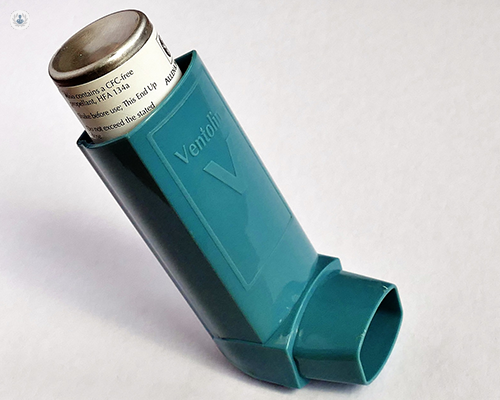Your guide to asthma: Key symptoms, diagnosis, and management
Escrito por:
Asthma is a common chronic respiratory condition that affects millions of people, making it difficult to breathe due to inflammation and narrowing of the airways. While there is no cure for asthma, it can be effectively managed with proper treatment and preventive measures.
Dr Syed Shah, renowned consultant respiratory physician, provides an in-depth look at asthma, discussing its symptoms, diagnosis, management options, as well as strategies to help prevent asthma attacks.

What is asthma?
Asthma is a chronic condition that affects the airways in the lungs, causing them to become inflamed, narrow, and produce excess mucus. This combination leads to difficulty in breathing.
Asthma symptoms can vary, but they may include:
- wheezing (a sharp, high-pitched whistling noise during breathing)
- shortness of breath
- chest tightness, pressure, or constriction
- coughing, which tends to be more severe at night or in the early morning
In some cases, asthma symptoms are triggered by specific factors, such as allergens (for example, dust mites), physical activity, or respiratory infections. These triggers cause the airways to react by tightening and swelling, which makes breathing difficult.
How is asthma diagnosed?
A medical history and symptom review is performed first, in which your respiratory physician will ask about your symptoms, their frequency, and any known triggers. Additionally, they will also ask about your family history, as asthma can be hereditary.
Your respiratory physician will then perform a physical examination to look for signs of asthma or other conditions with similar symptoms, such as respiratory infections or chronic obstructive pulmonary disease (COPD).
Subsequently, a series of lung function tests will be performed. These might include:
- Spirometry: A spirometry is a lung function test that measures how much air you can exhale after taking a deep breath and how quickly you can do it. A low reading indicates restricted airflow, which is a sign of asthma.
- Peak flow meter: A peak flow meter is a portable device used to measure the strength of your exhalation. Persistently low peak flow readings may indicate asthma.
How is asthma treated?
Asthma is treated with two types of medications:
Long-term control medications: These medications are taken daily to prevent asthma symptoms from occurring, which helps to reduce inflammation in the airways and keep them open. Examples include inhaled corticosteroids, leukotriene modifiers, and long-acting beta agonists (LABAs).
Quick-relief (rescue) medications: These medications provide immediate relief during an asthma attack by relaxing the muscles surrounding the airways. They are often used when symptoms flare up or before exposure to known triggers (for example, exercise). Examples include short-acting beta agonists (SABAs).
For people with severe asthma that doesn’t respond to traditional treatment, biologic therapies may be used. These target specific proteins or cells that contribute to asthma, helping reduce inflammation and asthma attacks.
Will asthma change with age?
Asthma can change with age. Some people may experience improvement in their symptoms as they get older, while others may notice a worsening over time due to changes in lung function, immune system, or lifestyle.
Childhood asthma often manifests early, particularly in response to allergies or viral infections, and while some children may "outgrow" the condition, others continue to experience symptoms into adulthood.
Asthma that develops later in life, known as adult-onset asthma, is also more likely to cause persistent symptoms, especially if those affected are exposed to occupational hazards or have a history of allergies.
If you would like to book an appointment with Dr Shah, head on over to his Top Doctors profile today.


